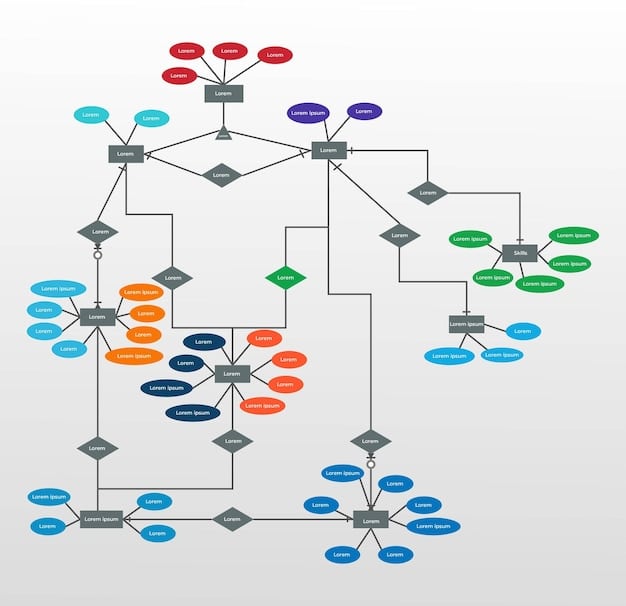AI-Powered Personalization: Reshaping Customer Journeys by 2025

By 2025, AI-powered personalization will transform customer journeys by enabling highly tailored experiences, predictive engagement, and seamless interactions across all touchpoints, enhancing customer satisfaction and driving business growth.
The landscape of customer experience is constantly evolving, and 2025 is set to be a pivotal year. How will AI-powered personalization reshape customer journeys by 2025? This question is not just a matter of technological advancement but a core element in how businesses will connect with and cater to their customers in the near future.
The Current State of Personalization
Personalization in customer journeys is no longer a novel concept. It has moved from being a luxury to a necessity for businesses aiming to remain competitive. Today, companies use various methods to understand their customers better and offer tailored experiences.
Data-Driven Insights
Collecting and analyzing data is fundamental to current personalization strategies. Companies gather information from multiple sources, including browsing history, purchase records, social media activity, and survey responses. This data helps them create customer profiles and predict future behavior.
Segmentation and Targeting
Based on the data collected, customers are often segmented into different groups. These segments are then targeted with specific marketing messages and product recommendations. This approach ensures that customers receive information that is relevant to their interests and needs.

However, despite these advancements, current personalization strategies often fall short. Many businesses still rely on basic demographic data and generalized assumptions, leading to experiences that feel generic and impersonal. The true potential of personalization lies in moving beyond these superficial approaches and leveraging the power of artificial intelligence.
Here are some ways that companies try to target personalization today:
- Utilizing customer relationship management (CRM) systems for tracking interactions.
- Employing email marketing tools for personalized messaging.
- Using website analytics to tailor content based on browsing behavior.
While these methods offer a level of personalization, they often lack the depth and sophistication that AI can provide. With the rapid advancements in AI technology, 2025 promises to bring a new era of hyper-personalization, where customer journeys are dynamically adapted in real-time based on individual needs and preferences.
AI’s Role in Revolutionizing Personalization
Artificial intelligence is set to redefine the boundaries of personalization. Its ability to process vast amounts of data, identify patterns, and make predictions with unmatched accuracy will enable businesses to create customer journeys that are not only personalized but also predictive and proactive.
Predictive Analytics
AI algorithms can analyze historical data to forecast future customer behavior. This allows businesses to anticipate customer needs and offer solutions before they are even explicitly requested. For example, an e-commerce platform could predict that a customer is likely to need a specific product soon and proactively offer a discount or promotion.
Real-Time Adaptation
One of the most significant advantages of AI-powered personalization is its ability to adapt in real-time. AI algorithms can monitor customer interactions and adjust the journey accordingly. If a customer shows signs of frustration or confusion, the system can automatically offer assistance or modify the experience to better suit their needs.
AI not only improves the effectiveness of personalization, AI also make it efficient. Some examples of personalization include:
- Chatbots offering instant support and guidance.
- AI-driven recommendation engines suggesting relevant product.
- Personalized content creation adapting messages to individual preferences.
Chatbots are also increasingly sophisticated. Advancements in natural language processing and machine learning have allowed chatbots to understand and respond to customer inquiries with greater accuracy and empathy. These AI-powered assistants can handle a wide range of tasks, from answering simple questions to resolving complex issues, providing seamless and personalized support to customers.
Key Technologies Driving AI Personalization by 2025
Several key technologies are converging to drive the advancement of AI-powered personalization. These technologies include machine learning, natural language processing, computer vision, and edge computing. These innovations will transform customer interactions.
Machine Learning (ML)
Machine learning algorithms are at the core of AI personalization. ML enables systems to learn from data without being explicitly programmed. This allows AI to identify patterns, make predictions, and continuously improve its performance over time. ML algorithms can be used to personalize recommendations, predict customer behavior, and optimize marketing campaigns.
Natural Language Processing (NLP)
Natural Language Processing enables machines to understand, interpret, and generate human language. NLP is crucial for AI-powered chatbots, voice assistants, and sentiment analysis. By understanding the nuances of human language, NLP allows businesses to communicate with customers more effectively and deliver personalized experiences based on their individual needs and preferences.

Computer Vision
Computer vision enables machines to “see” and interpret images. This is useful for AI-powered personalization in retail and e-commerce. For example, computer vision can be used to analyze product images and recommend similar items to customers based on their visual preferences. It can also be used to personalize in-store experiences by recognizing customers and displaying relevant product information on digital displays.
These technologies working together is crucial to providing true personalization. Here are some examples of their applications:
- Using ML to analyze past purchases and predict future needs.
- Employing NLP to understand customer sentiment in real-time.
- Leveraging computer vision to personalize product recommendations based on visual preferences.
As these technologies continue to advance, we can expect AI-powered personalization to become even more sophisticated and precise.
Examples of Reshaped Customer Journeys in 2025
To truly understand the impact of AI-powered personalization, let’s explore some hypothetical examples of how customer journeys could be reshaped by 2025. These examples span various industries and illustrate the potential of AI to create more engaging and relevant experiences.
E-commerce
Imagine a customer browsing an online fashion store. Instead of seeing generic product recommendations, they are presented with items that match their personal style, body type, and past purchases. AI-powered algorithms analyze their browsing history, social media activity, and even their physical measurements to generate highly personalized recommendations. The customer can also use a virtual try-on tool to see how the clothes will look on them, further enhancing the personalized experience.
Healthcare
In the healthcare industry, AI can personalize treatment plans and improve patient outcomes. AI algorithms can analyze patient data, including medical history, genetic information, and lifestyle factors, to identify potential health risks and recommend personalized preventative measures. Patients can also use AI-powered virtual assistants to monitor their health, receive medication reminders, and communicate with their healthcare providers.
AI can improve customer journeys in just about any vertical. Here are some additional examples:
- In travel, AI can recommend personalized itineraries based on travel history.
- In finance, AI can offer customized financial advice and investment strategies.
- In education, AI can personalize learning paths and provide adaptive tutoring.
These examples showcase the versatility of AI-powered personalization and its potential to transform customer journeys across a wide range of industries. By 2025, we can expect to see more and more businesses adopting AI-driven solutions to deliver truly personalized experiences to their customers.
Challenges and Considerations for Implementation
While AI-powered personalization offers immense potential, there are also challenges and considerations that businesses must address to ensure successful implementation. These include data privacy, ethical concerns, bias mitigation, and the need for ongoing monitoring and adaptation.
Data Privacy and Security
Collecting and analyzing customer data is essential for AI-powered personalization, but it also raises concerns about data privacy and security. Businesses must ensure that they comply with all relevant data privacy regulations, such as GDPR and CCPA. They must also implement robust security measures to protect customer data from unauthorized access and breaches. Transparency and customer consent are crucial, and businesses should be upfront about how they collect, use, and protect customer data.
Ethical Considerations
AI-powered personalization can also raise ethical concerns, particularly around questions of algorithmic bias and discrimination. AI are only as good as the data. Businesses must be vigilant in monitoring their AI systems for bias and discrimination and taking steps to mitigate these risks. This includes ensuring that the data used to train AI algorithms is diverse and representative and that the algorithms themselves are designed to be fair and unbiased.
There are several things that should be considered with AI implementations:
- Ongoing updates of AI algorithms with new data.
- Testing AI-powered personalization experiences.
- Having humans oversee the AI to assure the best customer experience.
Successfully implementing and staying on top of AI tools will ensure that the customer experience is the best that it can be. By addressing these challenges and considerations, businesses can harness the power of AI-powered personalization.
Preparing for the Future of AI Personalization
As we approach 2025, businesses should be taking proactive steps to prepare for the future of AI-powered personalization. This includes investing in the right technologies, building the necessary skills and expertise, and fostering a culture of data-driven decision-making. This will keep ahead of the rapid technological advances.
Investing in AI Technologies
Businesses should invest in AI technologies and infrastructure that will enable them to collect, analyze, and act on customer data in real-time. This includes investing in machine learning platforms, natural language processing tools, and data analytics software. It also includes investing in cloud-based infrastructure that can scale to meet the demands of AI-powered personalization.
Building AI Skills and Expertise
AI also requires having the right people in place, whether it’s training people you have or hiring externally. Businesses should invest in training and development programs to build the skills and expertise necessary to implement and manage AI-powered personalization. This includes training data scientists, machine learning engineers, and customer experience professionals.
Here is a list of items to think about when planning for future AI deployments:
- Prioritizing data privacy and security in all AI initiatives.
- Fostering a culture of transparency and customer-centricity.
- Monitoring AI systems for bias and discrimination.
The path towards integrating AI for personalization in customer journeys is marked by considerations of technology, ethics, and strategy. It will also require a focus and collaboration of many key areas of the business.
| Key Point | Brief Description |
|---|---|
| 🚀 Predictive Analytics | AI algorithms forecast customer behavior to anticipate needs before they arise. |
| 🤖 Real-Time Adaptation | AI dynamically adjusts customer journeys based on real-time interactions and feedback. |
| 🔒 Data Privacy | Complying with regulations like GDPR and CCPA is crucial for AI implementation. |
| 🛠️ AI Technologies | Invest in ML platforms, NLP, and data analytics to enable AI personalization. |
FAQ
▼
AI-powered personalization uses artificial intelligence to tailor customer experiences. It analyzes data to predict needs and preferences, offering relevant content and recommendations in real-time.
▼
AI uses machine learning algorithms to analyze historical data, such as purchase history and browsing activity. The algorithms then identify patterns and trends to forecast what a customer might do next.
▼
Key technologies include machine learning, natural language processing, and computer vision. Machine learning helps in making predictions, NLP assists in understanding language, and computer vision helps analyzing visual preferences.
▼
Businesses must comply with data privacy regulations and implement robust security measures. Transparency with customers about data use and obtaining consent are also critical steps for data privacy.
▼
AI improves customer engagement, satisfaction, and brand loyalty. It allows businesses to deliver relevant experiences, anticipate needs, and optimize interactions, driving growth and enhancing the overall customer journey.
Conclusion
As we look towards 2025, it’s clear that **AI-powered personalization** will be a driving force in shaping customer journeys. By understanding the technologies, addressing the challenges, and embracing a customer-centric approach, businesses can harness the power of AI to create experiences that delight and engage their customers, leading to increased loyalty and growth.





